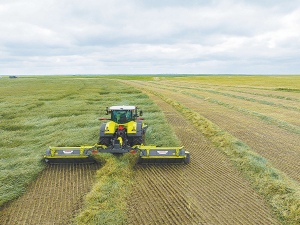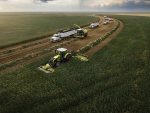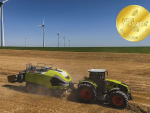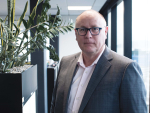Claas has closed the gap in the DISCO 9200/9300 and the DISCO 1100 wide mower ranges, with the arrival of the new 9700 range triple set up.
Each uses Max Cut mower beds and Active Float suspension technology and a range of optional conditioning and auto-swathing functions.
With a variable working width of 8.8 to 9.5 metres, the new range is offered in five variants: the Disco 9700 Comfort, 9700 C Business (tine conditioner), 9700 RC Business (roller conditioner), 9700 C Auto Swather (tine conditioner and swath grouping) and 9700 RC Auto Swather (roller conditioner and swath grouping).
The mowers feature swinging arms that can be hydraulically extended outwards by 30cm and retracted by 5cm, allowing the working width to adjusted on-the-go by up to 70cm. This allows maximum overlaps on headlands to avoid strips or maximum working width when mowing in parallel lands.
Mower units are driven by new triple telescopic drive shafts with toughened large-diameter steel profiles that enable the wide adjustment range of the mower arms. A new, higher capacity K-90 friction clutch is bolted directly to the universal joint shaft, for quick and easy servicing.
On the Comfort model, the Active Float ground pressure control, swing arm travel and protective cover folding are controlled via ISOBUS and load-sensing, while the arms are lifted and lowered by operation of the hydraulic spool valves, allowing integration of the lifting and lowering functions into the tractor’s headland management system.
Business spec machines see all functions controlled using a continuous load-sensing hydraulic system via the ISOBUS terminal, function keys or the tractor’s headland management system.
RC models feature two counter-rotating polyurethane rollers that are both actively driven and synchronised for maximum throughput and processing quality, extending fully across the width of the mower bed to gently crush the harvested crop and optimise crop flow. RC models are specifically developed for gently processing large volumes of lucerne, forage crops and whole-crop silage.
AutoSwather models incorporate two newly-designed 1100mm wide Kevlar-reinforced conveyor belts that consolidate harvested crop from the left and right hand mowers into a single, perfectly-shaped swath, ready for processing by a silage harvester, with a capacity to handle yields of up to 60 t/ha.
Each belt can be independently disengaged and folded away if swath grouping is not required. Additionally, one or both units can be folded hydraulically when using the ‘19 to 12’ method that consolidates 19m of material into 12m for the next pass with a 12.7m wide quad-rotor swather.
In lighter crops, the Max Cut mower beds can be operated at a reduced 850rpm PTO speed, helping to reduce fuel consumption by up to 20%, while new, optional wear skids provide an increased cutting height of 15mm, helping to reduce the amount of crude ash contamination introduced into the swath and promoting faster pasture regrowth.
Max Cut mower beds also incorporate Class’ rapid blade-change system, that sees the caps and mower blades of the clockwise and anti-clockwise rotating mower discs painted black and red, respectively, meaning replacement blades can be immediately assigned to the appropriate mower discs. This is complemented by a new blade box divided into three compartments for red and black replacements and used blades.
The Active Float system regularly and automatically continually adjusts the ground pressure, ensuring the mowers adapt perfectly to ground contours. Tried and tested for almost two decades, the contact pressure can be independently adjusted on either side for mowing borders and slopes, with a display in the terminal or via two gauges on the headstock.
An innovative hitch frame with angled arms ensures optimum centre of gravity during operation.


















